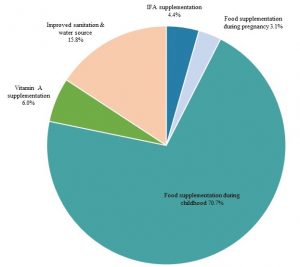
The LiST-based estimations of contributors to stunting cases prevented among children under 5 years of age in India between 2006 and 2016, by intervention (total stunting cases prevented in 10 years 2006–16: 4 590 908 children)
India has witnessed a substantial improvement in the coverage of nutrition-specific interventions between 2006 and 2016. Researchers from the International Food Policy Research Institute (IFPRI) used Lives Saved Tool (LiST), a computer-based model that estimates the impact of scaling up key interventions to improve maternal, newborn and child health, to model the impact of scaling up health programs in India between 2006 and 2016 and compared estimates to observed changes.
This study, published in the Health, Policy and Planning journal, was designed as an illustration to help researchers see the usefulness of this tool to study national and subnational level scaling up of health programs.
Data from the third and fourth rounds of the National Family Health Survey (NFHS-3 & NFHS-4), conducted in 2006-06 and 2015-16 respectively, shows that the proportion of women who had at least four antenatal care visits during pregnancy increased from 37 percent to 51 percent and protection against neonatal tetanus improved from 76 percent to 89 percent during this decade. Consumption of IFA supplements during pregnancy doubled from 15 percent in 2006 to 30 percent in 2016. Similar changes were observed for food supplementation during pregnancy, deliveries at health facilities and births assisted by skilled birth attendants.
There were improvements in the coverage of childhood nutrition interventions too, like early initiation of breastfeeding, supplementary feeding and exclusive breastfeeding. The coverage of immunization and vitamin A supplementation improved substantially in the last decade, and the proportion of children receiving oral rehydration salts (ORS) during diarrhea also increased. Use of improved sanitation facilities improved, but even in 2016, less than 50 percent of households reported using such facilities.
Using LiST, a publicly available tool that is designed to model the impact that scaling up key health interventions would have on outcomes of public health interest, IFPRI researchers, Harold Alderman, Phuong Hong Nguyen and Purnima Menon, found that at the national level for India, the reductions in stunting and child mortality that LiST predicts, based on changes in coverage of services between 2006 and 2016, are similar to—indeed slightly less than—the actual outcomes as observed in NFHS-4. Predictions of mortality improvements seem to be closer to the actual than those for improvements in stunting. Estimated changes in child mortality at the national level are close to observed changes. However, changes from the LiST projection for state-level estimates of under-five mortality were smaller than the actual changes between NFHS-3 and NFHS-4 for all states. Reasons for poorer performance of state-specific projections are unknown. Further refinements to the tool for subnational use would improve its usefulness.
It is crucial for governments and policymakers to know how much the expansion of a particular health or nutrition intervention coverage can potentially support the achievement of a related nutrition target. This study, that has examined projected trends versus actual outcomes over a decade in India, the country with the largest number of child deaths and stunted and anemic children in the world, sheds light on the tool performance at the national and subnational level. It strengthens the use of modelling tools, such as LiST, for priority-setting in public health programs so that nutrition targets set by the National Nutrition Mission, or POSHAN Abhiyaan, can be strategically achieved.
(Access this article: Alderman, H., P. H. Nguyen, and P. Menon. 2019. “Progress in reducing child mortality and stunting in India: an application of the Lives Saved Tool”. Health Policy and Planning, czz088. https://doi.org/10.1093/heapol/czz088)


